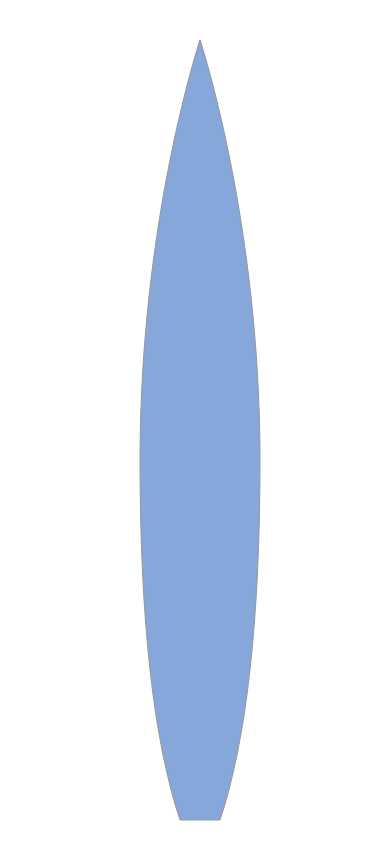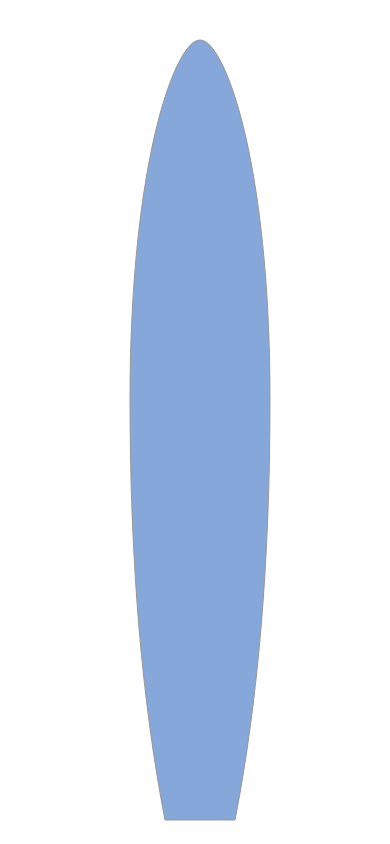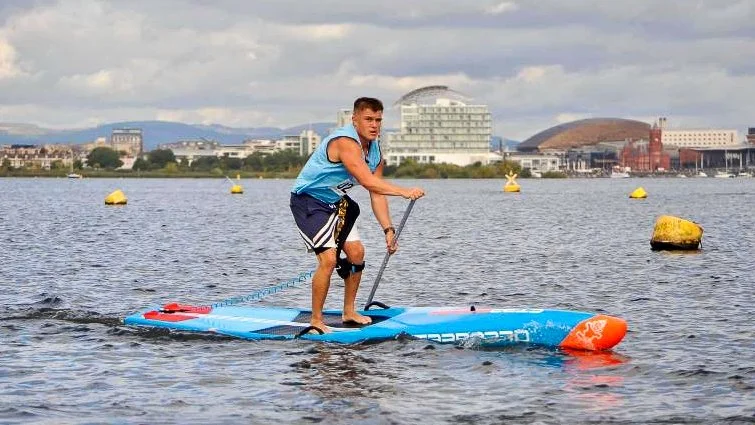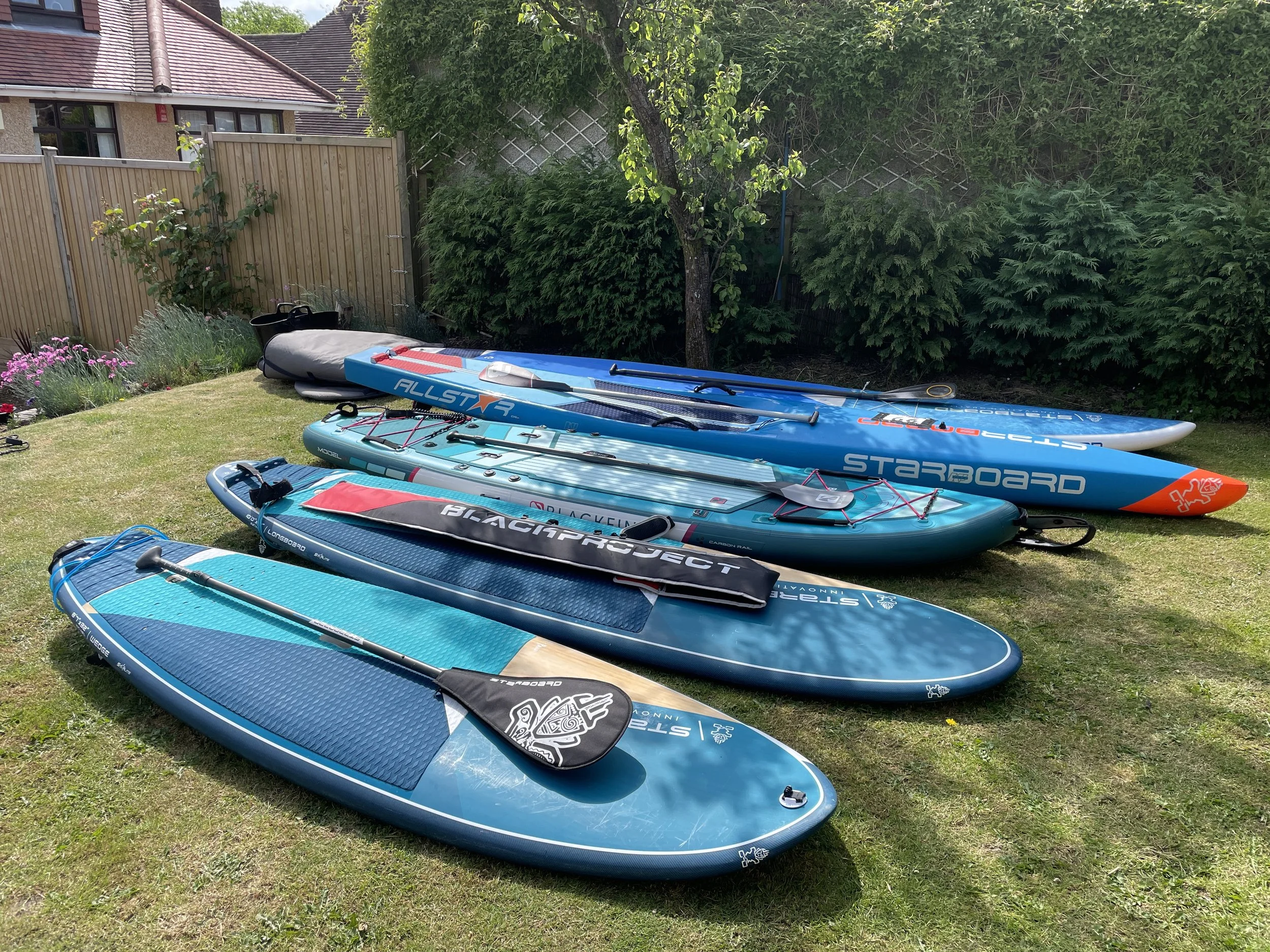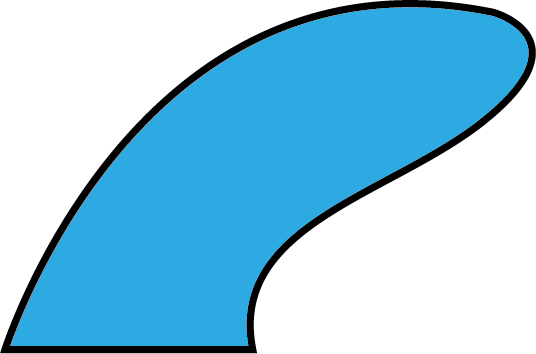Choosing the right board for your needs?
To find the perfect SUP for you, think about how you’re going to use the board, your experience as a paddler, the size and shape of the board, and its volume and weight capacity. Also, consider how you’ll store and transport your board - inflatable SUPs are much easier to transport, yet hard boards have a slight edge in performance. Finally, don’t forget about the accessories you’ll need to make your paddling experience more enjoyable.
“inflatable SUPs can be easier to transport
rigid boards generally offer better performance.”
Inflatable SUPs are made of sturdy PVC layers with a cross-stitch (sometimes called drop-stitch) construction. You may be surprised just how rigid it feels when you stand on it. Their distinctive cross-stitch construction and high-pressure inflation give them remarkable rigidity. A good inflatable SUP will come with a high-pressure hand pump, iSUP backpack, and fin, and is generally less expensive than hard SUPs.
Consider an Inflatable Paddle Board if:
Portability is Important and You Have Limited Storage: with an iSUP you don’t need a garage or large space to store your board. You also won’t need roof racks on your car.
You’re a Beginner: Inflatable paddle boards are excellent for beginners: they are very durable and resistant to dings and drops. iSUPs are an excellent way to introduce yourself to stand up paddling.
You plan to try SUP Yoga: The most comfortable choice for yogis, iSUPs sit higher on the water and are softer than hard boards.
River & Whitewater Paddling: If you plan to paddle on rivers or whitewater, an iSUP will handle rocks, logs, and bumps better than a solid board.
Hard paddle boards can be made in a variety of ways. The core of a hard paddleboard is EPS foam, which is coated in a variety of materials like fiberglass, epoxy, plastic, carbon fibre, or wood. Carbon Fibre boards are extremely light and rigid, but they are also very expensive. A cheap, entry-level alternative is a plastic, soft-top board. Epoxy and fibreglass boards are excellent middle-of-the-road options.
Performance takes precedence over portability:
Hard paddle boards are generally faster and more stable than iSUPs.
In the surf and in SUP racing, a hard paddleboard will outperform an inflatable.
Because hard SUPs are so huge, they must be stored indoors and away from the elements.
To transport your board safely, you'll need to install a roof rack on your vehicle.
How you will use your board?
When you first dip your toe in the water, you may not know what your needs are going to be, for many starting off, it will be a short paddle with friends on flat water traveling just a few kilometers. As you progress you may want to travel further and faster, to do this you start to think about upgrading your kit and perhaps buy different shaped boards that perform in different conditions. Investing in the right equipment can be a game-changer. Generally speaking, you pay for what you get, and that is worth remembering when you are starting out, and not sure if it is going to be a fully-fledged hobby.
The Paddle Equation: This sport is all about padding and having a good paddle can put less stress on your body, allowing you more time on the water, and enabling you to travel further.
Shape Matters: Long and thin = fast and straight, Short and wide = slower but maneuverable. Harder to track in a straight line)
Volume counts: The greater your skill and experiences the less volume is needed
Race Board
Touring Board
All Rounder
Surf Sup
GBSUP Event at Cardiff Bay
Race Boards at Caswell Bay
Paddleboards: Shapes and Sizes
Race Competitions are run in classes and as a result board lengths are used in most instances to determine classifications. The longer boards are 14ft and 12ft 6”. Most beginner boards range from 1oft to 11ft 6”. Surf Sups range from approx 8 ft to 10ft 5” . Volume, width, and depth are also considerations. Race boards are narrow and tend to be between 22” and 26”. Surf Sups and Beginner boards are somewhere between 30” and 34”. Race boards have a canoe shape nose to help them push through chop. Surf Sups have an upturned nose to prevent nose-diving when catching a wave. Three fins increase maneuverability but can cause drag.
Top Down:: Raceboard, Touring Board, iSup All Rounder, iSUP Entry, Surf SUP, Advanced Surf Sup
Top Down:: Touring Board, Raceboard, iSup All Rounder, iSUP Entry, Surf SUP, Advanced Surf Sup
Paddling Experience?
The best advice is to start off with a forgiving and stable board. Learn you’re limitations and how to adapt to changing conditions. As your confidence grows, so should your performance. Speak to others and share experiences, you will soon understand what works and importantly what doesn’t. Never lose respect for the water, your safety, and the safety of others.
BEGINNER
You’re new to paddleboarding and looking to try the sport in a fun, exciting way. You’ll want to start on flat, calm water like a lake, pond, or protected bay. An Inflatable, All Around SUP will serve you well for a long time. Look for a SUP with enough volume to support more than your weight.
INTERMEDIATE
You’re an intermediate paddler if you’ve paddled many times and feel comfortable navigating flat to mildly choppy waters. You have used a variety of boards and you know your favorite way to experience SUP. An All-Around or Touring SUP will last you a long time as an intermediate paddler.
EXPERIENCED
You’ve been paddling boarding for a long time, and you may have even taken classes. You know the proper paddling techniques, and you know your favourite spots to paddle. You may love SUP Yoga, SUP Fishing, or SUP Surfing. You know if you prefer speed over stability or portability over performance. You feel at home on calm water or in ocean chop, and you can paddle nearly any board, big or small. Touring SUPs, Surfing SUPs, and Racing SUPs are the most popular SUPs for advanced riders
Choosing a Board | Types of Paddle | Paddle Technique | SUP Safety
Choosing a Fin
The size and shape of the tail fin can affect the cruise, speed, stability and steering of the paddle. Those who play with the paddle a lot may notice these nuances. Trying to fine-tune the paddle by changing the tail fin may make you different performances in paddle-boarding. Among them, the following points are what you need to pay attention to:
The shape of the rudder
There are many different shapes of caudal fins on the market, but there are generally three common ones:
The swept back
The advantage is that the swept fin makes it easier to draw a straight line by moving the centre of gravity of the fin back, and because the tail fin has a larger surface area, it also makes the paddle more laterally stable, which belongs to the long-distance fin. The downside is that it will be a pain if the rower wants to make quick turns, it won't be the fastest tail fin due to its size and more drag.
Suitable Type: Long Cruise/Line Racing Board
The upright
The upright caudal fin is the opposite of the swept-back caudal fin, with most of its area remaining above the caudal fin. It will create less drag and be faster in water due to its smaller area. The advantage is that this fin shape is more suitable for paddlers who want to paddle and turn quickly. The disadvantage is that it is not suitable for walking in a straight line.
Applicable type: Race board
The general all-round fin
This is the most common type of tail fin, probably used by 80% of paddles. It combines the swept type and the upright type with each other, providing the best choice of two types of fins, and it can be regarded as an all-round fin.The advantage is that the shape of the tail fin is suitable for use in surfing and generally calm water, especially for beginners. The downside is that it doesn't work with more performance class expert racing paddles.
FIT TYPE: A full range of paddleboards are available from cruising to surfing.
In Summary
A larger tail fin will improve tracking and stability; Smaller tail fins will improve speed and steering manoeuvrability.
The position of the caudal fin
In many cases, we will find that the size of the caudal fin slot may be much longer than that of the caudal fin. This is because different positions of the caudal fin in the caudal fin slot will have different effects and bring different experiences. Then we are installing the caudal fin. When, where should the caudal fin be placed in the caudal fin groove?
1. The tail fin is at the head of the board
Better for: Surfing
The advantage is: the tail fin is close to the head of the board, which will make your board more flexible and responsive, making it easy to catch waves. Therefore, it is recommended to use this type of installation while surfing. But the disadvantage of this method is also obvious, that is, it is not very good to walk in a straight line, and the board is easy to drift sideways.
2. The tail fin is at the tail of the board
Better for: Long cruising paddling
The tail fin is close to the tail of the board to increase the stability and speed of the board, but it is just the opposite of being installed at the head of the board. This installation method is more suitable for walking in a straight line, so it is often used in straight-line racing or long-term paddle cruises. But that means it turns slower, and if you need to paddle long distances and want to maximize your cruising speed, you can mount the tail fin at the end of the deck.
The disadvantage is: it is more suitable for walking in a straight line, the steering takes a little effort, and if you want to turn faster, you need your body center of gravity to step back to achieve the effect of fast turning.
3. The caudal fin is located in the middle of the slot
Better for: Any situation that requires compatibility with cruise time and flexibility. This is the most common installation method and the most versatile way to use it. It is compatible with stability and speed. If you are not sure which installation effect you need, it is recommended to install it in the middle.
The number of caudal fins
1. Single caudal fin
It has only one middle caudal fin and is dominated by a large caudal fin, which is usually used for paddling in flat or still water. While reducing the number of tail fins, it perfectly reduces drag and adds extra speed. But because there is only one tail fin, the stability is not very good, which means that the rower needs to have a better balance.
2.2+1 tail fin
It is a large central caudal fin, plus two smaller lateral caudal fins. Compared to a single fin, a 2+1 fin has a clear advantage in overall stability, but increases drag and reduces speed.
3.4+1 tail fin
It is a large central caudal fin, plus four smaller lateral caudal fins. The middle tail fin is used to stabilise the board and control how the water moves under the tail of the board, and the side fins are used to guide the water and prevent your surfboard from sliding sideways. More suitable for advanced paddlers looking for a good balance of stability, speed and manoeuvrability, may be slightly difficult for beginners.
Other factors
1. Tail fin weight
Generally, the stiffer the tail fin, the more power, driving force and speed it will produce, which is one of the main reasons why carbon fibre tail fins are used as premium high-end tail fins.
2. Profile and Fin Thickness
Thicker fins are slower than thin fins, however thin fins will have a smaller profile and likely not be as rigid as thicker fins, which is why many thinner fins are made of carbon fibre.
3. Tail fin size (total surface area)
The total surface area of the tail fin has a large effect on cruise, tracking, stability, steering and speed. A tail fin with a large surface area keeps the tail from sliding sideways with each stroke, keeping the paddle in a straight line. Therefore, the larger the tail fin, the better the lateral stability. But at the same time, the greater the surface area, the greater the drag when turning. As a result, it steers more slowly and with more effort. Likewise, less surface area makes steering easier, but reduces stability, especially in wave conditions. At the same time, the smaller tail fin has less resistance, making it faster and easier to row in the water.
In Brief:
Large fins are slower but more stable; Finlets are faster but unstable.
Sup Surfing at Langland Bay, Gower



